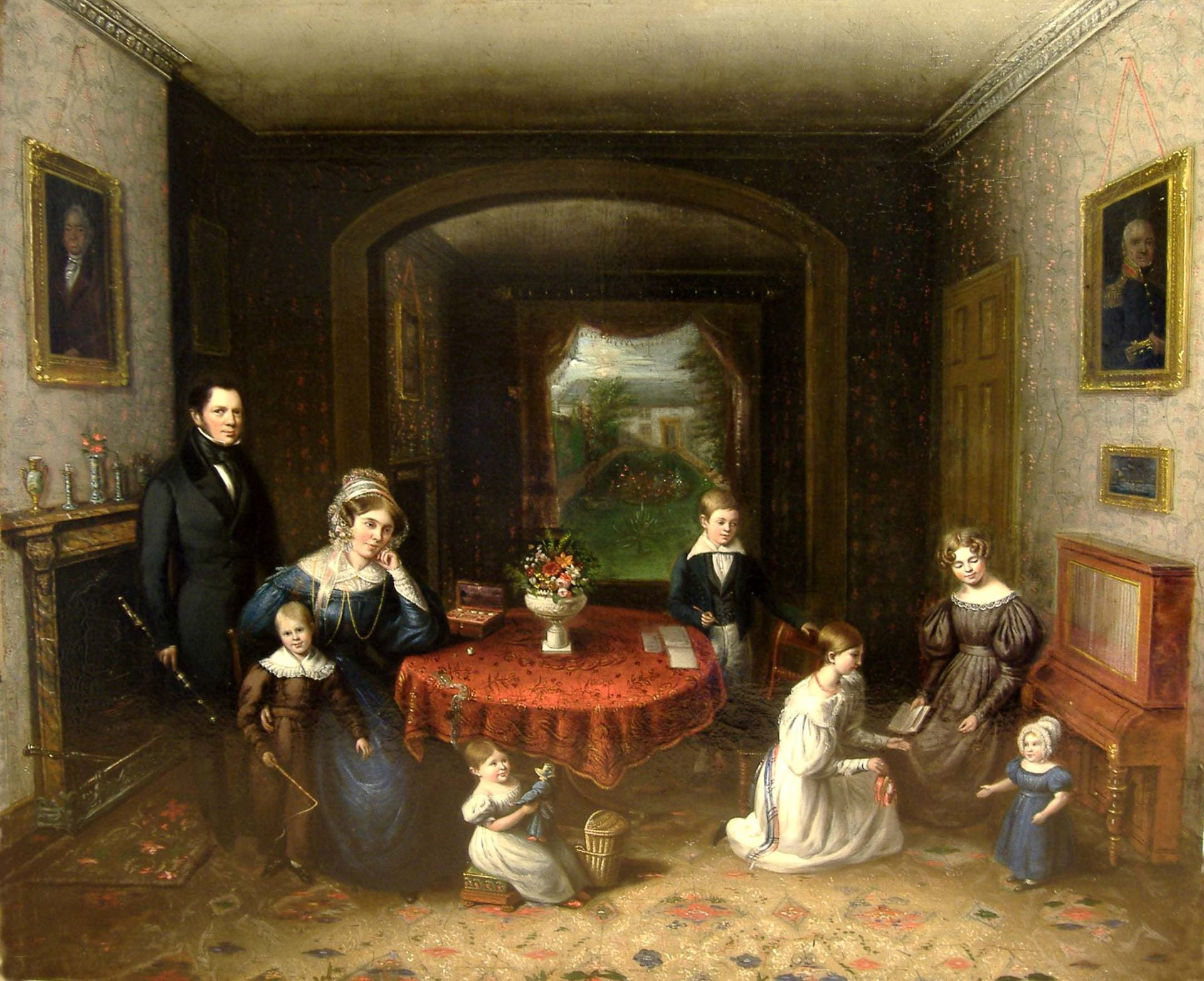By Michele Leggott
Professor R. Middleton (University of Bristol) is a direct descendant of Edwin Harris’s older brother James Cobham Harris (1794-1876) [JCH]. Professor Middleton got in touch earlier this year to explain the connection and to forward a selection of images that depict portraits of the Harris family in his possession. We knew already that JCH was a professional portrait painter, but not that he and Edwin were among, according to family legend, 23 children of James Pasco Harris (1771–1846) [JPH, (known as James Jnr in the family)] and Mary Roberts Harris (née Good) (1774–1850). Our searches have uncovered eleven children of the marriage, but there may well be more undocumented births and infant mortality rates were very high at this time.
Most importantly for our research, it seems that JCH painted two family portraits, one circa 1825, the other circa 1840, both of which are owned by Professor Middleton. The 1840 group portrait shows JCH and his family of eight children at the point when Edwin and Sarah Harris departed with their children from Plymouth, bound for what would become the settlement of New Plymouth in New Zealand. There are references to JCH and to the business of painting in Edwin’s letters to his parents written during the difficult years of early settlement. It is clear that the English family supported their emigrant son as best they could, sending art supplies and fittings for Edwin and Sarah’s timber cottage. Here is Edwin’s 1844 request to his father:
You desire me to mention any particular thing that I may want or be desirous of having sent out. I will therefore mention some things but you are not to put yourself to the slightest inconvenience or to think of sending all that I might mention. In the first place I should like much some of the cheap paper hangings that I remember seeing before I left sufficient to paper a room 10 ft by 10 and say 7 ft high; a small quantity of Flake White as I intend trying an oil picture or so having all the other colours; a cake of Prussian blue; two or three cheap chairs without being put together might be laid very well in such a box as the one we received last; cheap drapery for a french bed would be exceedingly acceptable.
A drawing of the house shall be sent in another letter as I find I have too much to say to find a corner anywhere in this. (The Family Songbook 13)
In 1845 Edwin reported receiving art supplies from his father and made some new requests:
I am very much pleased with the oil colours they were in excellent order & condition. I have of course made use of them and like the method of keeping them very much. It is next to James’ plan and for small quantities superior. Will you in the next send me a Phial bottle of mastic varnish & if you can afford it I should be glad of a set of Guitar strings which will cost from 4 to 5 shillings. I have made a guitar, Music being our only amusement. The evenings are long, lights bad for drawing and books only for those who can get them. (The Family Songbook 16)

But it is JCH’s 1825 group portrait of the Harrises that is most intriguing. It shows parents James Jnr and Mary and 10 of their children. Nobody is identified but Professor Middleton’s notes indicate that one daughter is Catherine Jane (Kate) (1799-1884) and another, younger, is Emily Augusta (1809-74). Both would marry civil engineers who became significant: the former James Meadows Rendel MICE (1799–1856), who founded the Rendels as an engineering dynasty, and the latter George Clarisse Dobson MICE (1801–74). One of their children was Henry Austin Dobson (1840-1921), poet and literary biographer. There would be two further Dobson-Harris marriages in the nineteenth and twentieth centuries.
Both sisters figure in 1840s correspondence with Edwin and Sarah Harris. In 1825 Kate would have been 26 and Augusta 16. It is interesting to note that Augusta’s first given name is Emily. Are we looking at the source of Emily Cumming Harris’s name in that of the aunt closest in age to Edwin? Edwin himself was 19 in 1825, the year he painted the interior of St Andrew’s Church in Plymouth as proof of his competence as a fine art student. We can perhaps make an educated guess as to which young man in the family group is the painter Edwin Harris, knowing that brothers James (29), Theodosius Henry (14) and Henry Marmaduke (10) are also likely sitters.

James is still going on very comfortably, has tolerable health and a pretty good share of employment not withstanding this patent Photography Society. Perhaps you may not have heard of the extraordinary invention, that of taking likenesses by means of throwing the shadow of the person on the ivory bit. As this can only be seen in a certain light I do not think that James will lose much by it. (The Family Songbook 7)
We are grateful to Professor Middleton for sharing his research and images, some of which we have added to our new Harris family photos page.